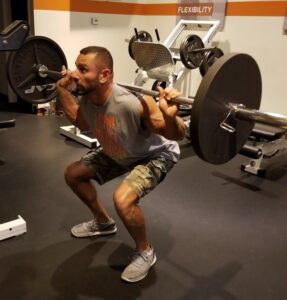Exercise Name & Target Muscle Group
The back squat (commonly referred to as the squat) is a multi-joint compound resistance exercise that typically uses a squat rack and barbell (weighted or unweighted).
The squat is a sagittal plane exercise in which the hip extension and knee extension are the primary joint movements on the upward (concentric) phase (the opposite movements – hip and knee flexion are the primary joint movements in the downward phase).
The primary hip extensors are the gluteus maximus, the semimembranosus, semitendinosus, and biceps femoris (hamstrings) while the knee extensors include the vastus lateralis, vastus intermedius, vastus medialis, and rectus femoris (quadriceps).
Why It’s Performed
The squat is used to develop the gluteal, quadriceps and hamstring muscle groups. The squat is also considered a “core” exercise in that it develops the major muscles associated with a strong central core. The back squat is not typically performed with a new client who has no experience with free weight exercises. It’s best to start a new/inexperienced client out with body weight squats or wall sits to teach proper form and extension/flexion.
HOW TO DO A BACK SQUAT
Proper Execution
For a standard back squat, execute it properly by:
Starting Position
- Position the barbell evenly on top of the posterior deltoids at the middle of the trapezius. For a higher bar placement, place the bar evenly at the base of the neck (just above posterior deltoids).
- Use a closed pronated grip to grasp the bar at slightly wider than shoulder-width apart.
- Raise the elbows to create a shelf with the muscles of the upper back and shoulders for the bar to rest upon.
- Position the feet between hip- and shoulder-width apart with toes pointed slightly outward so knees will track over the feet.
- Keep the chest up and out to create a neutral or slightly arched back. Do not round the shoulders or flex the neck.
NOTES: If we were being picky about this pic (and we are), then we would suggest that his wrists be neutral (and neck too), head tilted down a little more and eyes forward.
Downward Phase
- Flex the hip and knees slowly to begin the downward movement.
- Maintain neutral spine and high elbow position.
- Keep the body’s weight centered and over the middle and heel area of the feet. Keep the heels on the floor.
- Keep knees aligned over the feet as the knees become parallel to the ground.
- Do not bounce and begin the upward phase when one of these three criteria are met:
- The thighs are parallel to the ground
- The torso rounds or flexes forward
- The heels rise off the ground
NOTE: Squat depth varies greatly based on lower body flexibility; a parallel position may not be achievable for some. Spotters are always recommended.
Variations of the Exercise
The squat can be performed in a variety of ways including the following.
- Body Weight Squat
- Front Squat
- Dumbbell Squat
- Squat using a BOSU Ball
- Plie Squat
- Overhead Squat
- One-legged Squat
- Hack Squat
- Split Squat
Common Errors
- Improper bar placement
- Shoulders round forward
- Not using a full range of motion to perform the movement
- Not using collars on the barbell
- Lifting the heels off the ground
- Exhaling too soon and not on exertion (upward phase)
- Extending the neck too far back
- Not pushing through the heels on the upward phase
- Uneven foot placement
- Collapsing knees inward (sign of weak glutes or tight adductors – or both)
[info type=”facebook”]If you’re an NFPT trainer, join the Facebook Community Group to become involved with your peers today and if you’re not, come chat with NFPT here![/info]




